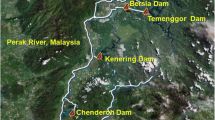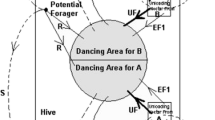Abstract
In reservoir system operation, optimization is very much essential and the compatibility of different optimization techniques is essential to be checked by some performance checking indices. In this study, various types of performance-measuring index are used and compared to provide a complete knowledge on adopting different approaches. Here, the considered performance-measuring indicators will check the operation policy in terms of three different scenarios—how the method is efficient in achieving best results (reliability); how vulnerable the method is for different critical situation (vulnerability); and how capable it is to handle a failure of the model (resiliency). Therefore, the study proposed the artificial bee colony (ABC) optimization technique to develop an optimal water release policy for the well-known Aswan High Dam, Egypt. Particle swarm optimization, genetic algorithm and neural network-based stochastic dynamic programming are also used in a view of comparing model performances. A release curve is developed for every month as a guidance to the decision maker. Simulation has been done for each method using historical actual inflow data, and reliability, resiliency and vulnerability are measured. All model indicators proved that the release policy provided by ABC optimization outperforms in terms of achieving minimum water deficit, less waste of water and handling critical situations.










Similar content being viewed by others
References
Ahmed JA, Sarma AK (2005) Genetic algorithm for optimal operating policy of a multipurpose reservoir. Water Resour Manag 19:145–161. doi:10.1007/s11269-005-2704-7
Chang F-J, Chen L (1998) Real-coded genetic algorithm for rule-based flood control reservoir management. Water Resour Manag 12:185–198
El-Shafie AH, El-Manadely MS (2011) An integrated neural network stochastic dynamic programming model for optimizing the operation policy of Aswan High Dam. Hydrol Res 42:50–67. doi:10.2166/nh.2010.043
Hashimoto T, Stedinger JR, Loucks DP (1982) Reliability, resiliency, and vulnerability criteria for water resource system performance evaluation. Water Resour Res 18:14–20
Haupt RL, Haupt SE (2004) Practical genetic algorithms, 2nd edn. Wiley, Hoboken
Jothiprakash V, Shanthi G (2006) Single reservoir operation policies using genetic algorithm. Water Resour Manag 20:917–929. doi:10.1007/s11269-005-9014-y
Kamp RG, Savenije HHG (2006) Optimising training data for ANNs with genetic algorithm. Hydrol Earth Syst Sci 10:603–608. doi:10.5194/hess-10-603-2006
Karaboga D, Akay B (2009) A comparative study of artificial bee colony algorithm. Appl Math Comput 214:108–132. doi:10.1016/j.amc.2009.03.090
Karaboga D, Basturk B (2007) A powerful and efficient algorithm for numerical function optimization: artificial bee colony (ABC) algorithm. J Glob Optim 39:459–471. doi:10.1007/s10898-007-9149-x
Karaboga D, Basturk B (2008) On the performance of artificial bee colony (ABC) algorithm. Appl Soft Comput 8:687–697. doi:10.1016/j.asoc.2007.05.007
Karaboga D (2005) An idea based on honey bee swarm for numerical optimization. Technical report–TR06. Kayseri, Turkey
Kim T, Heo J-H (2004) Multireservoir system optimization using multi-objective genetic algorithm. In: Critical transitions in water and environmental resources management. Proceedings of world water and environmental resources congress
Kumar DN, Reddy MJ (2007) Multipurpose reservoir operation using particle swarm optimization. J Water Resour Plan Manag ASCE 133:192–201. doi:10.1061/(ASCE)0733-9496(2007)133:3(192)
Loucks DP, Beek EV, Stedinger JR, Dijkman JP, Villars MT (2005) Water resources systems planning and management: an introduction to methods, models and applications. UNESCO Publishing, Paris
Moy W, Cohon JL, Revelle CS (1986) A programming model for analysis of the reliability, resilience, and vulnerability of a water supply reservoir. Water Resour Res 22:489–498
Noureldin A, El-Shafie A, Bayoumi M (2011) GPS/INS integration utilizing dynamic neural networks for vehicular navigation. Inf Fusion 12:48–57. doi:10.1016/j.inffus.2010.01.003
Oliveira R, Loucks DP (1997) Operating rules for multireservoir systems. Water Resour Res 33:839–852
Rao Z, Jamieson DG (1997) The use of neural networks and genetic algorithms for design of groundwater remediation schemes. Hydrol Earth Syst Sci 1:345–356. doi:10.5194/hess-1-345-1997
Seibert J (2000) Multi-criteria calibration of a conceptual runoff model using a genetic algorithm. Hydrol Earth Syst Sci 4:215–224. doi:10.5194/hess-4-215-2000
Serdjevic B, Obradovic D (1998) Firm water and shortage index in water systems performance analysis. In: Pannonian applied mathematical meeting (PAMM), Hungary, pp 1–6
Hong TP, Huang KY, Lin WY (2002) Applying genetic algorithms to game search trees. Soft Comput 6:277–283. doi:10.1007/s005000100154
Tereshko V (2000) Reaction-diffusion model of a honeybee colony’s foraging behavior. In: Proceedings of PPSN VI: parallel problem solving from nature. Lecture notes in computer science, Springer, pp 807–816. doi:10.1007/3-540-45356-3_79
Wang RL, Okazaki K (2007) An improved genetic algorithm with conditional genetic operators and its application to set-covering problem. Soft Comput 11:687–694. doi:10.1007/s00500-006-0131-1
Wardlaw R, Sharif M (1999) Evaluation of genetic algorithms for optimal reservoir system operation. J Water Resour Plan Manag ASCE 125:25–33
Wurbs RA (1996) Modelling and analysis of reservoir system operations. Prentice-Hall, Inc, Upper Saddle River, NJ, USA
Acknowledgements
The research is fully funded by the internal grant of University Tenaga Nasional (J510050526). The authors are grateful to the UNITEN and Sustainable Clean Energy research institute to support the study.
Author information
Authors and Affiliations
Corresponding author
Rights and permissions
About this article
Cite this article
Hossain, M.S., El-Shafie, A., Mahzabin, M.S. et al. System performances analysis of reservoir optimization–simulation model in application of artificial bee colony algorithm. Neural Comput & Applic 30, 2101–2112 (2018). https://doi.org/10.1007/s00521-016-2798-2
Received:
Accepted:
Published:
Issue Date:
DOI: https://doi.org/10.1007/s00521-016-2798-2




